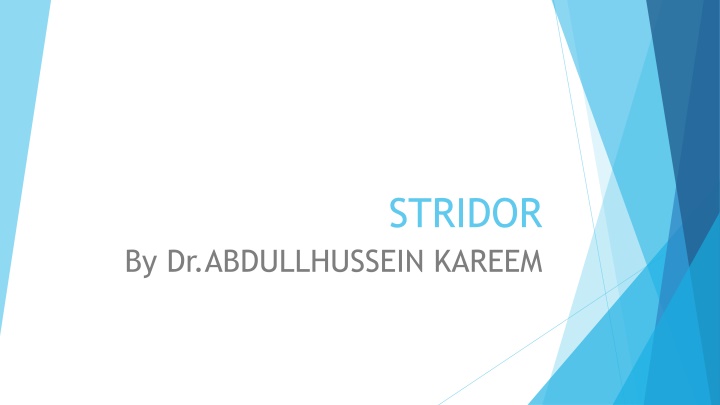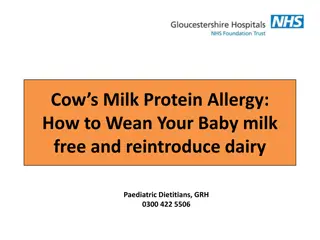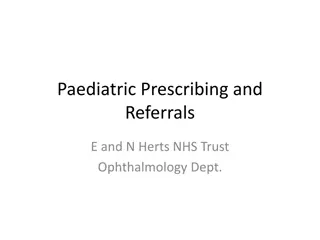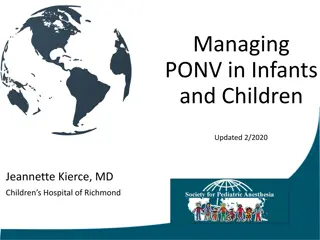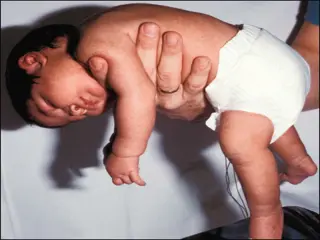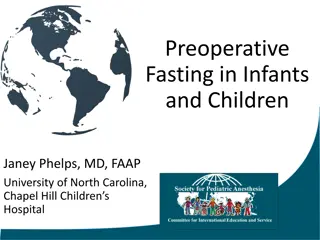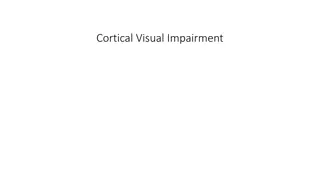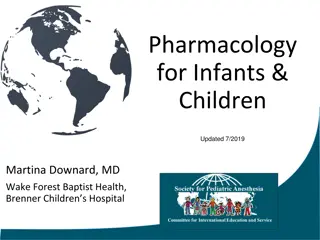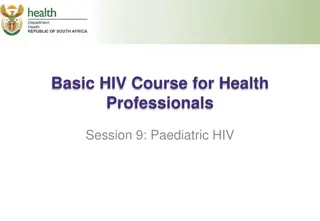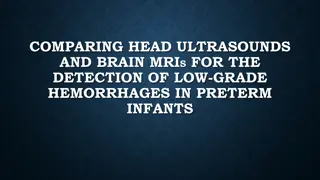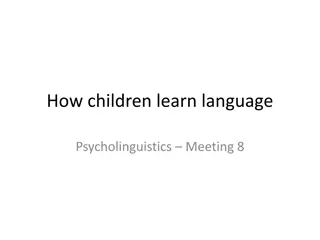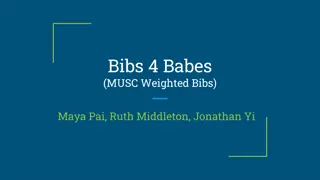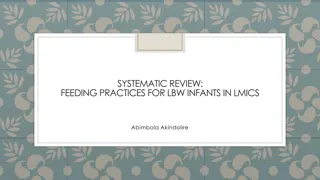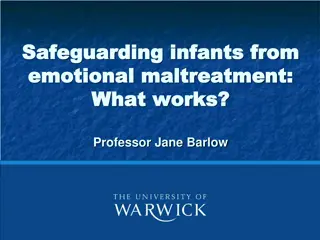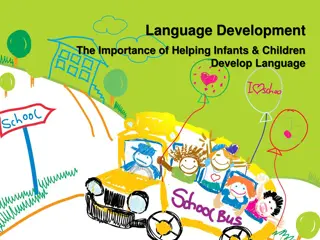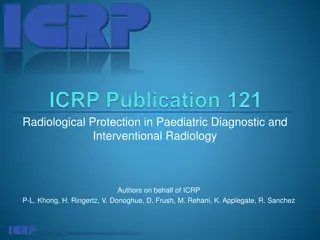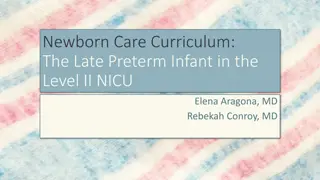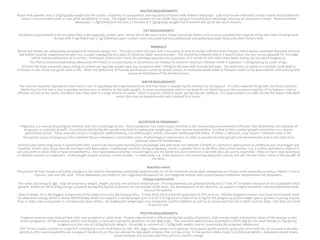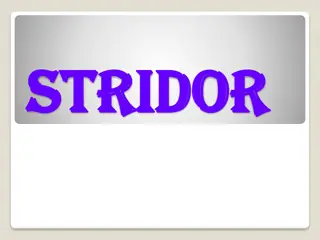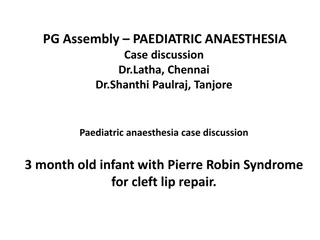Stridor in Infants and Children
Stridor is an abnormal high-pitched, musical sound caused by airway blockages in the larynx or trachea. Differentiating it from stertor is crucial, and understanding the underlying causes is essential for proper treatment. Infants and children are more at risk due to factors like richer lymphatic drainage and decreased ability to expel secretions. Clinical grades help in assessing severity, with different interventions based on the symptoms presented.
Download Presentation

Please find below an Image/Link to download the presentation.
The content on the website is provided AS IS for your information and personal use only. It may not be sold, licensed, or shared on other websites without obtaining consent from the author.If you encounter any issues during the download, it is possible that the publisher has removed the file from their server.
You are allowed to download the files provided on this website for personal or commercial use, subject to the condition that they are used lawfully. All files are the property of their respective owners.
The content on the website is provided AS IS for your information and personal use only. It may not be sold, licensed, or shared on other websites without obtaining consent from the author.
E N D
Presentation Transcript
STRIDOR By Dr.ABDULLHUSSEIN KAREEM
Stridor is an abnormal high-pitched ,musical sound due to blockage or partial obstruction in the larynx or trachea and should be differentiated from stertor which is low_ pitched ,noisy breath generated at the level of the nasopharynx,oropharynx or supraglottis. Stridor may be inspiratory due to laryngeal obstruction or expiratory due to tracheobronchial obstruction or biphasic due to glottic or subglottic obstruction. Stridor is a symptom not disease and the underlying cause should be determined to be treated accordingly.
Stridor in infants and children is more serious than in adults due to the following factors. 1.The lymphatic drainage of the larynx is richer in the child and so the submucosa is more likely to swell. 2.The neuromuscular mechanism is more easily upset and spasm more easily provoked. 3.The child is less able to expel the secretions by coughing.
Clinical grades of stridor. 1.Exertional stridor ;stridor appears during crying or exercise. 2.Continuous stridor or stridor at rest; stridor is present at rest and becomes worse with exertion, here the infants should be admitted to hospital. 3.stridor with retractions; stridor is continuous and accompanied with suprasternal and supraclavicular retractions, the patient looks anxious ,irritable and struggling for breathing.Hospitallization is indicated for all cases. 4.Stridor with cyanosis; continuous stridor, retractions in addition to cyanosis and altered consciousness, here urgent endotracheal intubation or tracheostomy is needed.
Etiology. 1.Congenital. A.Larynx ,laryngomalacia,web,saccular cyst, vocal cord paralysis, subglottic stenosis and subglottic hemangioma. B.Trachea and bronchi,web ,stenosis,tracheomalacia,compression from vascular and mediastinal tumours. 2.Acquired (FIAT). A.Trauma,thermal and chemical,iatrogenic(intubation and surgical),external blunt and sharp trauma.B.
B.Inflammatory,acute laryngitis,acute laryngotracheobronchitis and diphtheria. C.Foreign body,laryngeal,tracheal and bronchial. D.Allergy,angioneurotic edema of the larynx and trachea. E.Neoplasia,benign like laryngeal papilomatosis and malignant like laryngeal or bronchial carcinoma. Clinical features. Stridor is inspiratory in supraglottic lesions and expiratory in tracheal lesions ,other clinical features depend on the underlying causes.
Clinical assessment in adults Age of the patient. Onset of stridor sudden or gradual. Duration of stridor. Progression and severity. History of smoking and alcohol. Past medical history and any trauma or surgery.
In infants and children Age of onset. Duration,progression and severity of stridor. Precepitating factors(feeding or crying). Relation of stridor to position supine or prone. Other symptoms like cough,aspiration,drooling,choking,cyanosis and sleep disturbances. Severity like color change,respiratory effort and apnea. Perinatal history,development and growth,vaccination.
Examination. Complete ENT examination should be performed . Cardiovascular and respiratory systems examination. If we suspect the child has epiglottitis ,examination by tongue depressor should be avoided for the risk of laryngeal spasm which may be fatal . Endoscopic examination. Investigations. -Blood gas analysis. CBC and CRP.
-Radiological study like plain x-ray of the chest and neck,CT scan and MRI depending on the cause. Laryngomalacia. It is the commonest cause of chronic stridor in infancy and early childhood ,it occurs due to an indrawing of floppy supraglottic structures(particularly the arytenoid and aryepiglottic folds) during inspiration.The condition may appear within an hour or two of birth. Presentation. Stridor may be slight and present in certain positions or it increases during respiratory tract infections and if severe it interferes with feeding and associated with retractions.
The symptoms gradually improve with time but may take several years to stop. Diagnosis. Is done by endoscopic examination of the larynx and sometimes under GA to see the floppy larynx and exclude associated vocal cord palsy,the epiglottis is omega shaped. Treatment. Follow__up and reassurance to the parent. Surgical removal of lax mucosa by laser. Tracheostomy is unknown for laryngomalacia and if considered ,an associated vocal cord palsy should be suspected and excluded. -
Multiple laryngeal papillomatosis. Single papilloma occurs in adults arising from the free edge of a vocal cord and it is liable for recurrence and malignant changes and should be removed. Multiple papillomatosis ,in contrast, occurs in infants due to infection of the epithelial cells with human papilloma virus(HPV) type 6and 11,it may be transmitted at time of delivery from a mother infected with genital warts. Pathology. Papillomas can occur at any age from birth to 5 years and may grow anywhere in the respiratory tract from the lips to the lungs but commonly affect the vocal cords ,anterior commissure and vestibular folds.
The lesions have predilection for points of airway constriction, where there is increased air flow ,drying, crusting and irritation. The growths may present as scattered single lesions or clusters or as a huge exuberant mass,sessile or pedunculated. Clinical features. Change of voice or an abnormal cry is the presenting symptom. Respiratory obstruction and increasing stridor are late manifestations. Diagnosis. Endoscopy is required to establish the diagnosis ,obtain tissue for histopathology and to assess the extent of the disease.
Treatment. The aim of R is to remove the papilloma ,to maintain a safe patent airway and laryngeal function. 1.Medical treatment. A.Alpha interferon . B.Isotretinoin. 2.Surgical treatment. By laser especially CO2 type ,many sessions may be needed for the patient due to high recurrence rate . Tracheostomy should be avoided if possible as the papillomas can become implanted into the trachea and bronchi.
